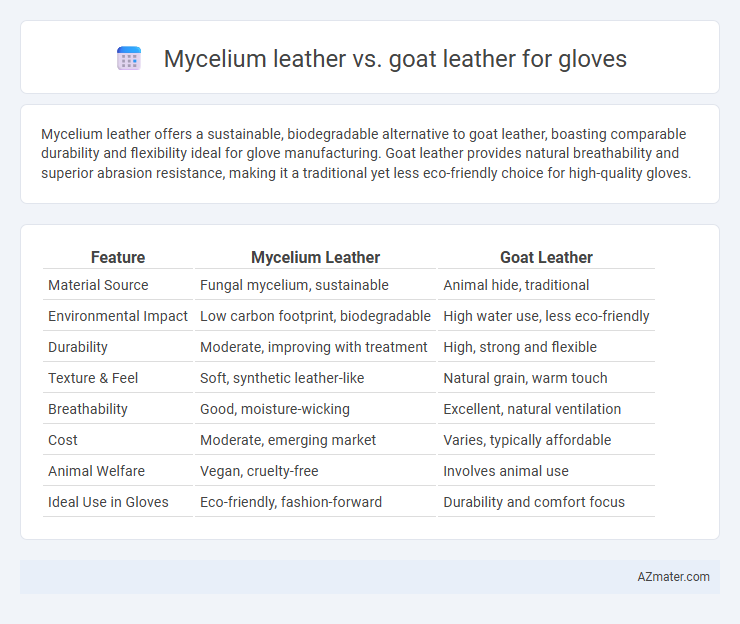Mycelium leather offers a sustainable, biodegradable alternative to goat leather, boasting comparable durability and flexibility ideal for glove manufacturing. Goat leather provides natural breathability and superior abrasion resistance, making it a traditional yet less eco-friendly choice for high-quality gloves.
Table of Comparison
| Feature | Mycelium Leather | Goat Leather |
|---|---|---|
| Material Source | Fungal mycelium, sustainable | Animal hide, traditional |
| Environmental Impact | Low carbon footprint, biodegradable | High water use, less eco-friendly |
| Durability | Moderate, improving with treatment | High, strong and flexible |
| Texture & Feel | Soft, synthetic leather-like | Natural grain, warm touch |
| Breathability | Good, moisture-wicking | Excellent, natural ventilation |
| Cost | Moderate, emerging market | Varies, typically affordable |
| Animal Welfare | Vegan, cruelty-free | Involves animal use |
| Ideal Use in Gloves | Eco-friendly, fashion-forward | Durability and comfort focus |
Introduction to Mycelium Leather and Goat Leather
Mycelium leather, derived from mushroom root fibers, offers a sustainable and eco-friendly alternative to traditional animal hide with qualities like breathability and flexibility ideal for gloves. Goat leather, known for its lightweight yet durable texture, delivers natural strength and superior tactile sensitivity, favored in high-quality glove manufacturing. Both materials present unique benefits, with mycelium leather emphasizing environmental sustainability and goat leather offering time-tested performance and comfort.
Overview of Glove Material Requirements
Glove materials must balance durability, flexibility, breathability, and comfort to ensure effective hand protection and dexterity. Mycelium leather offers a sustainable and biodegradable alternative with notable abrasion resistance and water repellency, while goat leather is prized for its natural softness, superior tensile strength, and moisture-wicking properties. Selecting the optimal glove material depends on the specific use case, prioritizing factors like durability for work gloves or flexibility for sports applications.
Production Processes: Mycelium vs Goat Leather
Mycelium leather is produced through sustainable fungal cultivation, where the root structure of mushrooms is grown on agricultural waste, enabling a low-impact, biodegradable material with reduced water and land use. Goat leather production involves animal husbandry, including raising goats for their hides, followed by complex tanning processes that often require hazardous chemicals, contributing to environmental pollution and higher carbon footprints. The production of mycelium leather offers a faster, eco-friendly alternative to traditional goat leather, aligning with sustainable manufacturing goals in glove fabrication.
Durability and Strength Comparison
Mycelium leather for gloves offers exceptional durability due to its tensile strength and resistance to wear, often outperforming traditional goat leather in longevity under regular use. Goat leather is known for its natural flexibility and toughness, but it may show signs of wear faster compared to mycelium leather, which resists cracking and degradation over time. Both materials provide strong protection, but mycelium leather's sustainable composition enhances durability without compromising glove performance.
Comfort and Fit for Gloves
Mycelium leather offers superior breathability and flexibility compared to traditional goat leather, enhancing overall glove comfort by reducing hand sweat and improving ventilation. Goat leather provides a natural, snug fit with excellent durability, molding closely to the hand over time for a personalized grip. For gloves, mycelium leather's lightweight structure ensures ease of movement, while goat leather excels in maintaining form-fitting support and resilience under frequent use.
Environmental Impact and Sustainability
Mycelium leather, derived from mushroom roots, offers a significantly lower environmental footprint compared to traditional goat leather, requiring less water, land, and producing fewer greenhouse gas emissions. Goat leather production involves intensive livestock farming practices that contribute to deforestation, methane emissions, and high water consumption, intensifying environmental degradation. Sustainable glove manufacturing increasingly favors mycelium leather for its biodegradability and renewable sourcing, supporting circular economy principles and reducing long-term ecological impact.
Cost Analysis: Mycelium Leather vs Goat Leather
Mycelium leather offers a competitive cost advantage compared to goat leather, primarily due to lower resource input and faster production cycles, reducing overall manufacturing expenses. Goat leather involves higher costs related to animal rearing, tanning processes, and environmental regulations, driving up the price per glove. For glove production, mycelium leather's sustainable sourcing and scalability present a more cost-effective option without compromising quality.
Aesthetic Qualities and Customization Options
Mycelium leather offers a unique, organic texture with natural color variations that provide a modern, eco-friendly aesthetic ideal for fashion-forward glove designs. Goat leather, known for its fine grain and soft, supple feel, delivers a classic, luxurious appearance favored in premium glove craftsmanship. Customization options for mycelium leather include eco-dyeing and laser engraving, while goat leather allows for traditional embossing, hand-painting, and a wide range of finishes to enhance durability and style.
Market Availability and Consumer Acceptance
Mycelium leather, derived from fungal roots, is gaining traction in the glove market due to its sustainable production and growing consumer interest in eco-friendly materials, yet it remains less widely available compared to traditional goat leather. Goat leather, known for its durability and suppleness, maintains strong market presence and consumer trust, especially in premium glove segments. Industrial scaling challenges and higher costs currently limit mycelium leather's widespread adoption despite its environmental benefits and emerging acceptance among eco-conscious buyers.
Future Trends in Glove Materials
Mycelium leather is rapidly emerging as a sustainable alternative to traditional goat leather in glove manufacturing, driven by its biodegradability and lower environmental impact. Innovations in mycelium processing enhance its durability and flexibility, aligning with increasing consumer demand for eco-friendly and cruelty-free products. As the industry advances, hybrid gloves combining mycelium and goat leather may become popular, optimizing performance while reducing ecological footprints.

Infographic: Mycelium leather vs Goat leather for Glove
 azmater.com
azmater.com